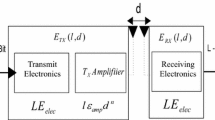Abstract
In wireless sensor networks, a clustering scheme is helpful in reducing the energy consumption by aggregating data at intermediate sensors. This paper discusses the important issue of energy optimization in hierarchically-clustered wireless sensor networks to minimize the total energy consumption required to collect data. We propose a comprehensive energy consumption model for multi-tier clustered sensor networks, in which all the energy consumptions not only in the phase of data transmissions but also in the phase of cluster head rotations are taken into account. By using this new model, we are able to obtain the solutions of optimal tier number and the resulted optimal clustering scheme on how to group all the sensors into tiers by the suggested numerical method. This then enables us to propose an energy-efficiency optimized distributed multi-tier clustering algorithm for wireless sensor networks. This algorithm is theoretically analyzed in terms of time complexity. Simulation results are provided to show that, the theoretically calculated energy consumption by the new model matches very well with the simulation results, and the energy consumption is indeed minimized at the optimal number of tiers in the multi-tier clustered wireless sensor networks.
Similar content being viewed by others
References
Akyildiz I F, Su W, Sankarasubramaniam Y, Cayirci E. Wireless sensor networks: A survey. Computer Networks, 2002, 38(4): 393–422.
Ye W, Heidemann J, Estrin D. An energy-efficient MAC protocol for wireless sensor networks. In Proc. the 21st Annual Joint Conference of the IEEE Computer and Communications Societies, June 2002, Vol.3, pp.1567-1576.
Dam T, Langendoen K. An adaptive energy-efficient MAC protocol for wireless sensor networks. In Proc. the 1st international Conference on Embedded Networked Sensor Systems, November 2003, pp.171-180.
Lu G, Krishnamachari B, Raghavendra C. An adaptive energy efficient and low-latency MAC for data gathering in wireless sensor networks. In Proc. the 18th International Parallel and Distributed Processing Symposium, April 2004.
Ye W, Heidemann J, Estrin D. Medium access control with coordinated adaptive sleeping for wireless sensor networks. IEEE/ACM Trans. Networking, June 2004, 12(3): 493–506.
Rhee I, Warrier A, Aia M, Min J, Sichitiu M. Z-MAC: A hybrid MAC for wireless sensor networks. IEEE/ACM Transactions on Networking, 2008, 16(3): 511–524.
Bulusu N, Estrin D, Girod L, Heidemann J. Scalable coordination for wireless sensor networks: Self-configuring localization systems. In Proc. the 6th International Symposium on Communication Theory and Applications, July 2001, pp.1-6.
Bulusu N, Heidemann J, Estrin D. Adaptive beacon placement. In Proc. the 21st IEEE International Conference on Distributed Computing Systems, April 2001, pp.489-498.
Elson J, Girod L, Estrin D. Fine-grained network time synchronization using reference broadcasts. In Proc. the 5th Symposium on Operating Systems Design and Implementation, December 2002, pp.147-163.
Elson J, Estrin D. Time synchronization for wireless sensor networks. In Proc. the 15th International Parallel and Distributed Processing Symposium, April 2001, pp.1965-1970.
Syed A, Heidemann J. Time synchronization for high latency acoustic networks. In Proc. the 25th IEEE Int. Conf. Computer Communications, April 2006, pp.1-12.
Heinzelman W, Chandrakasan A, Balakrishnan H. Energy-efficient communication protocol for wireless microsensor networks. In Proc. the 33rd Annual Hawaii International Conference on System Sciences, January 2000.
AI-Karaki J, Kamal A. Routing techniques in wireless sensor networks: A survey. IEEE Wireless Communications, 2004, 11(6): 6–28.
Intanagonwiwat C, Govindan R, Estrin D. Directed diffusion: A scalable and robust communication paradigm for sensor networks. In Proc. the 6th Annual Int. Conf. Mobile Computing and Networking, August 2000, pp.56-67.
Lindsey S, Raghavendra C. PEGASIS: Power-efficient gathering in sensor information systems. In Proc. IEEE Aerospace Conference, March 2002, Vol.3, pp.1125-1130.
Ye F, Luo H, Cheng J, Lu S, Zhang L. A two-tier data dissemination model for large-scale wireless sensor networks. In Proc. the 8th Annual International Conference on Mobile Computing and Networking, Sept. 2002, pp.148-159.
Bandyopadhyay S, Tian Q, Coyle E. Spatio-temporal sampling rates and energy efficiency in wireless sensor networks. IEEE/ACM Transactions on Networking, 2005, 13(6): 1339–1352.
Akkaya K, Younis M. A survey on routing protocols for wireless sensor networks. Ad Hoc Networks, 2005, 3(3): 325–349.
Bandyopadhyay S, Coyle E. An energy efficient hierarchical clustering algorithm for wireless sensor networks. In Proc. the 22nd Annual Joint Conference of the IEEE Computer and Communications, March 30-April 3, 2003, Vol.3, pp.1713-1723.
Bandyopadhyay S, Coyle E. Minimizing communication costs in hierarchically clustered networks of wireless sensors. Computer Networks, 2004, 44(1): 1–16.
Chen Y, Liestman A, Liu J. A hierarchical energy-efficient framework for data aggregation in wireless sensor networks. IEEE Transactions on Vehicular Technology, 2006, 55(3): 789–796.
Krishnamachari B, Estrin D, Wicker S. The impact of data aggregation in wireless sensor networks. In Proc. the 22nd International Conference on Distributed Computing Systems Workshops, July 2002, pp.575-578.
Foss S, Zuyev S. On a Voronoi aggregative process related to a bivariate Poisson process. Advances in Applied Probability, 1996, 28(4): 965–981.
Xue F, Kumar P. The number of neighbors needed for connectivity of wireless networks. Wireless Networks, 2004, 10(2): 169–181.
Author information
Authors and Affiliations
Corresponding author
Electronic Supplementary Material
Below is the link to the electronic supplementary material.
Rights and permissions
About this article
Cite this article
Meng, JT., Yuan, JR., Feng, SZ. et al. An Energy Efficient Clustering Scheme for Data Aggregation in Wireless Sensor Networks. J. Comput. Sci. Technol. 28, 564–573 (2013). https://doi.org/10.1007/s11390-013-1356-y
Received:
Revised:
Published:
Issue Date:
DOI: https://doi.org/10.1007/s11390-013-1356-y




